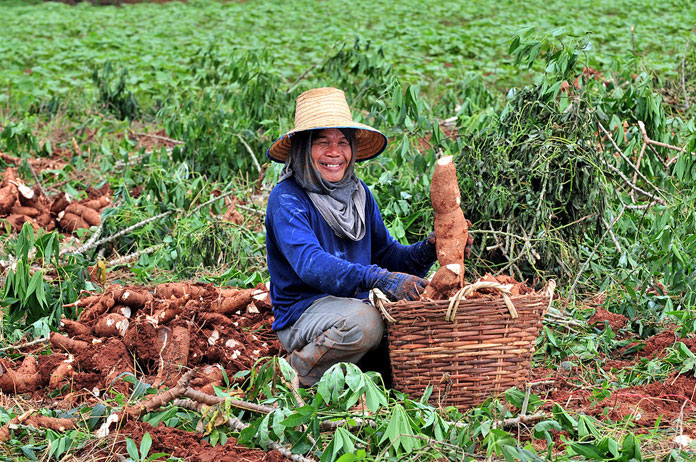Invest More In Processing Raw Materials, Says Hun Sen
By
B2B Cambodia
on
 The lack of agro processing factories in the Kingdom means that cassava growers cannot add value to their exports in the form of semi-processed products like cassava chips and starch.
Prime Minister Hun Sen called on investors to invest in the processing of raw materials to support the government’s 2015-2025 Industrial Development Policy (IDP).
“The supply of high quality, reliable and reasonable priced raw materials or inputs is essential for Cambodia’s industrial production,” the Premier told the Meeting of Christians for the Harmonisation of Christianity in the Country yesterday. “We are expanding markets for farmers and urging our neighbours to buy our agricultural products because we lack the facilities to process them ourselves."
Hun Sen said the IDP reviews the viability of providing support to small and medium enterprises for investment in machinery parts and production equipment, as well as other incentives, taking into consideration their ability to process local raw materials.
“We want investors to come here to help us process our agricultural products and existing raw materials,” he added. “We don’t want to export raw materials but rather we want them processed so that they can add value to our products that are bound overseas.”
The prime minister gave the examples of cassava and rubber production in the country. “The low price of cassava has been an issue for farmers in Cambodia due to the free-market cassava trade. There is also a lack of agro processing factories in the Kingdom for cassava growers to add value to their exports in the form of semi-processed products like cassava chips and starch. Because of this, Cambodia can only export unprocessed cassava.”
Touching on rubber production, Hun Sen said Cambodia could only export natural rubber bales which were subject to the vagaries of fluctuating global prices. “If we could use that natural rubber to make tyres, for instance, we would get better earnings from our exports,” he said.
According to the 2015-2025 IDP, the government aims to increase the GDP share of the industrial sector to 30 percent by 2025. It also plans to increase exports from the non-textile sector to 15 percent of all exports in the same period.
Cambodia's economic growth currently depends on traditional sectors such as garments, tourism, construction and agriculture. The government foresees that the country’s growth will be around 7 percent per annum in the medium term.
“Cambodia’s growth outlook in the medium term remains favourable, largely underpinned by export diversification,” stated the World Bank recently in its Cambodia Economic Update 2017 report.
This article was originally published in the Khmer Times.
The lack of agro processing factories in the Kingdom means that cassava growers cannot add value to their exports in the form of semi-processed products like cassava chips and starch.
Prime Minister Hun Sen called on investors to invest in the processing of raw materials to support the government’s 2015-2025 Industrial Development Policy (IDP).
“The supply of high quality, reliable and reasonable priced raw materials or inputs is essential for Cambodia’s industrial production,” the Premier told the Meeting of Christians for the Harmonisation of Christianity in the Country yesterday. “We are expanding markets for farmers and urging our neighbours to buy our agricultural products because we lack the facilities to process them ourselves."
Hun Sen said the IDP reviews the viability of providing support to small and medium enterprises for investment in machinery parts and production equipment, as well as other incentives, taking into consideration their ability to process local raw materials.
“We want investors to come here to help us process our agricultural products and existing raw materials,” he added. “We don’t want to export raw materials but rather we want them processed so that they can add value to our products that are bound overseas.”
The prime minister gave the examples of cassava and rubber production in the country. “The low price of cassava has been an issue for farmers in Cambodia due to the free-market cassava trade. There is also a lack of agro processing factories in the Kingdom for cassava growers to add value to their exports in the form of semi-processed products like cassava chips and starch. Because of this, Cambodia can only export unprocessed cassava.”
Touching on rubber production, Hun Sen said Cambodia could only export natural rubber bales which were subject to the vagaries of fluctuating global prices. “If we could use that natural rubber to make tyres, for instance, we would get better earnings from our exports,” he said.
According to the 2015-2025 IDP, the government aims to increase the GDP share of the industrial sector to 30 percent by 2025. It also plans to increase exports from the non-textile sector to 15 percent of all exports in the same period.
Cambodia's economic growth currently depends on traditional sectors such as garments, tourism, construction and agriculture. The government foresees that the country’s growth will be around 7 percent per annum in the medium term.
“Cambodia’s growth outlook in the medium term remains favourable, largely underpinned by export diversification,” stated the World Bank recently in its Cambodia Economic Update 2017 report.
This article was originally published in the Khmer Times.